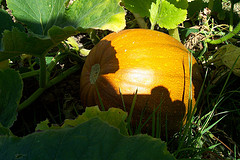Pumpkins
| Infobox on Pumpkins | |
|---|---|
| Example of Pumpkins |  |
| Freshness facts | |
| Optimum carrying temperature | 10°C to 13°C |
| Highest freezing point | -0,8°C |
| Acceptable product temp. at loading into containers | Max. 2°C above carrying temperature |
| Optimum humidity | 60% to 70% |
| Ventilation setting for containers | 10 m³/hr |
| Storage life | 2-3 months (cultivar dependent) |
| Climacteric / non-climacteric | Non-climacteric |
| Ethylene production | Low |
| Ethylene sensitivity | Low |
| Modified / controlled atmosphere | - |
| Potential benefits | Likely to show little benefit from CA |
| Availability | |
| New Zealand Central America Morocco Turkey |
January-April November-March November-May August-December |
Pumpkins
Contents
Harvesting and handling
The distinction between Pumpkins and Winter Squash is culinary rather than taxonomical. Pumpkins have coarser, stronger flavoured flesh and are used for pies. They are also used for decoration as Halloween jack-o-lanterns or for their edible seeds. Winter squash have finer textured and milder flavoured flesh. They are cooked and served as vegetables, and are commonly used for 'pumpkin' pies.
Pumpkins and Winter squash should be fully mature, with hard rinds and, except for some striped varieties, solid external colour. Flesh of good quality pumpkins and Winter squash is bright yellow or orange with fine, moist texture and high solids, sugars, and starch; over-mature flesh can become stringy. All pumpkins and Winter squashes should be well matured, carefully handled, and free from injury or decay. Pumpkins and Winter squashes are placed on racks, in bulk bins, or in baskets and are often held in ventilated or common storage in production areas.
Cooling and storage
Recommended conditions for storage of pumpkins and Winter squashes are 10°C to 13°C. High storage temperature (>15°C) will result in excessive weight loss, colour loss and poor eating quality. The relative humidity should be 60% to 70%. Higher humidity promotes fungal growth and decay; lower humidity causes excess weight loss and texture deterioration. At 10°C, squashes should generally keep for at least 2-3 months, cultivar dependent. Often squashes are stored for longer periods, but spoilage and shrinkage increase.
The surface of the produce should be kept dry, and storage rooms should have good air circulation. Pumpkins generally do not keep as well as hard-shelled Winter squashes. Most cultivars of Winter squash and pumpkins as well as the tropical pumpkins cannot be stored for more than 2 to 3 months. Good quality Hubbard squash can be stored 6 months at 10°C to 13°C and 70% relative humidity. A 15% loss in weight after 6 months is about average.
Both pumpkins and Winter squashes develop chilling injury at <10°C. Storage at 0°C to 4°C inhibits yellowing, but causes sunken pits on the fruit surface and loss of flavour. Alternaria rot develops on chilled squashes after removal from storage. Depending on cultivar, chilling injury symptoms develop after 1 month at 5°C or several months at 10°C.
Mixed loads
Pumpkins and Winter squash produce only trace amounts of ethylene, but wounding greatly increases ethylene production. Hubbard squash and other dark-green-skinned squashes should not be stored near apples, as the ethylene from apples may cause the skin to turn orange-yellow. Ethylene may also cause stem abscission; especially in less mature fruit.
Cautions
Controlled atmosphere storage has slight to no effect; decay may actually be greater due to higher relative humidity.
Storage disorders
Alternaria rot, Anthracnose, Bacterial rots, Black rot, Chilling injury, Cottony leak, Fusarium, Watery soft rot.











